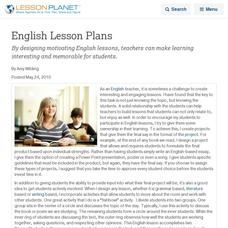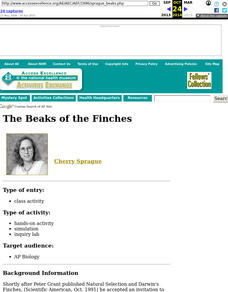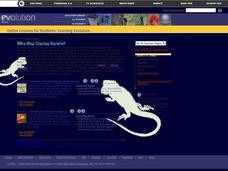Curated OER
Finite Differences
Young mathematicians solve problems with polynomials. As they graph and analyze polynomial functions, learners define constant and finite, and determine the relationship between the constant set of differences and the slope of a linear...
Curated OER
Solving Exponential Equations
Solving exponential and logarithmic equations is taught in this interactive lesson. Students use properties of logarithm and exponents solve functions. They estimate the solution and use the Ti to find the exact solution.
Curated OER
Our Town by Thornton Wilder
In this literature activity, students respond to 14 short answer and essay questions about Wilder's play Our Town. Students may also link to an online interactive quiz on the play at the bottom of the page.
Curated OER
Wetland Food Webs
Students study life science. In this food webs and food chains comparison lesson, students examine the wetlands to discover the relationships that exist between the animals that live there. They participate in group activities and...
Curated OER
Search for the Missing Pi
Third graders work in groups of two to three with measuring tapes, finding the circumference and diameter of teacher-selected circular items. They relate circumference and diameter measurements to find pi.
Curated OER
Cells
Students explore the cell and cell processes. They create "cytoplasm", make a model of the cell and its organelles, and simulate the osmosis and the diffusion of materials into and out of the cell.
Curated OER
Discovering Ohm's Law
Students explore the relationship of resistance, voltage, and current in series and parallel circuits using a computer model of a circuit board. They discover Ohm's Law by constructing series circuits.
Curated OER
Let's Gather Around the Circle
Scholars explore the relationship between circumference and diameter. Groups of learners measure the diameter and circumference of round objects and record their data on a given worksheet. They then input the data into their graphing...
Curated OER
First Rhythmic Composition
Young scholars apply fractions to counting rhythm in music. In this algebra lesson, students interrelate the concept of math into music as they fill out a chart identifying the names and symbols of music notes and their equivalent values...
Curated OER
English Lesson Plans
By designing motivating English lessons, teachers can make learning interesting and memorable for students.
Curated OER
The Beaks of the Finches
Students become birds and are given "beak-types". After completing the simulation, students relate results to adaptations and natural selection. Extensions of the simulation allow for comparative results and include population genetics.
Curated OER
Life During the Civil War for Women and Civilians
Students follow an overview of the American Civil War from a film, the text and/or teacher direct instruction. They create a timeline with a large map of the U.S. in the 1860's available for student reference as they do the spider activity.
Curated OER
How Do Artists Get Their Ideas? Culture and Environment as Sources of Ideas
Students share the difficulties they have in determining what to write or draw for a project. In groups, they view examples from three different artists and discuss how their personal experiences affected their art. They brainstorm a...
Curated OER
The Science of Sound and Musical Instruments
Students identify the components of sound. They describe the relationship between pitch and frequency and explain the terms sympathetic vibrations and resonance.
They perform simple experiments about the world of sound and explain the...
Curated OER
Fueling Around with Energy: A Comparative Study of Conventional and Renewable Energy Use Among Nations
Ninth graders examine the relationship between energy and society. In groups, they define energy sources as renewable or conventional and research how each method contributes to the world's energy. They write about how the patterns of...
Curated OER
What's Missing?
Students examine their beliefs about archaeological preservation. They articulate a response to archaeological resource destruction. Students then complete two puzzles and relate them to archaeological research.
Curated OER
Chart Your Course
Students explore change represented in graphs comparing distance and time. They exchange and share their graphs. Students interpret and create distance versus time line-graphs, and write stories based on these graphs. They interpret a...
Curated OER
Tantalizing Tangrams
Students create puzzles of animals based on the 12-animals cycle of the Lunar Calendar. They use logical or spatial relationship skills. Students comprehend the mathematical term geometry. They research the history, beliefs of the...
Curated OER
Germination: Name that Seed
High schoolers investigate seeds, flowers and germinating seeds. In this germination lesson plan, students observe a stalk of corn, a corn seed, Gladiolas and glass jars containing germinating sees and plants. High schoolers answer 8...
Curated OER
Geographic Features and Human Settlements
Third graders examine geography and settlements. In this geography lesson, 3rd graders participate in classroom activities that center on the idea that people settle where there are geographical features that sustain life.
Texas Instruments
Expanding - Using CAS
Young scholars explore binomial multiplication. They use a TI-nspire handheld to investigate the relationship between the binomial multiplication problem and the resulting trinomial.
Curated OER
Financial Literacy - Careers and Income
Students practice filling out job applications, create resumes, simulate hiring process, discuss benefits offered to employees, hidden costs of a job, and the risks and rewards of being an entrepreneur or self-employed.
Curated OER
Who Was Charles Darwin?
Young scholars complete two activities to study Charles Darwin's Theory of Natural Selection. They read Darwin's journal from the voyage of the Beagle and look at the scientific ideas that influenced the development of his theory.
Curated OER
Man's Struggle for Environmental Preservation
Students examine the way all living things are connected to one another. In groups, they participate in experiments in which they analyze the chemical processes through the biosphere and explain the role of energy. They also brainstorm...

























